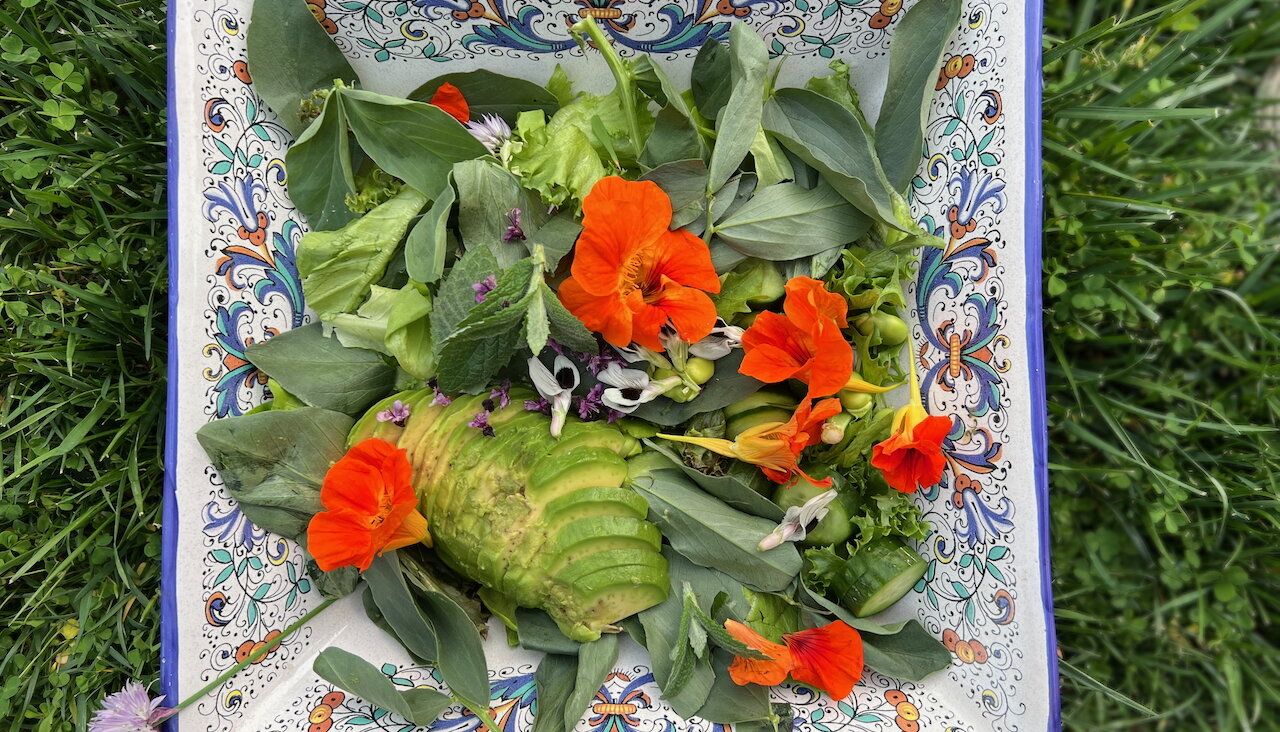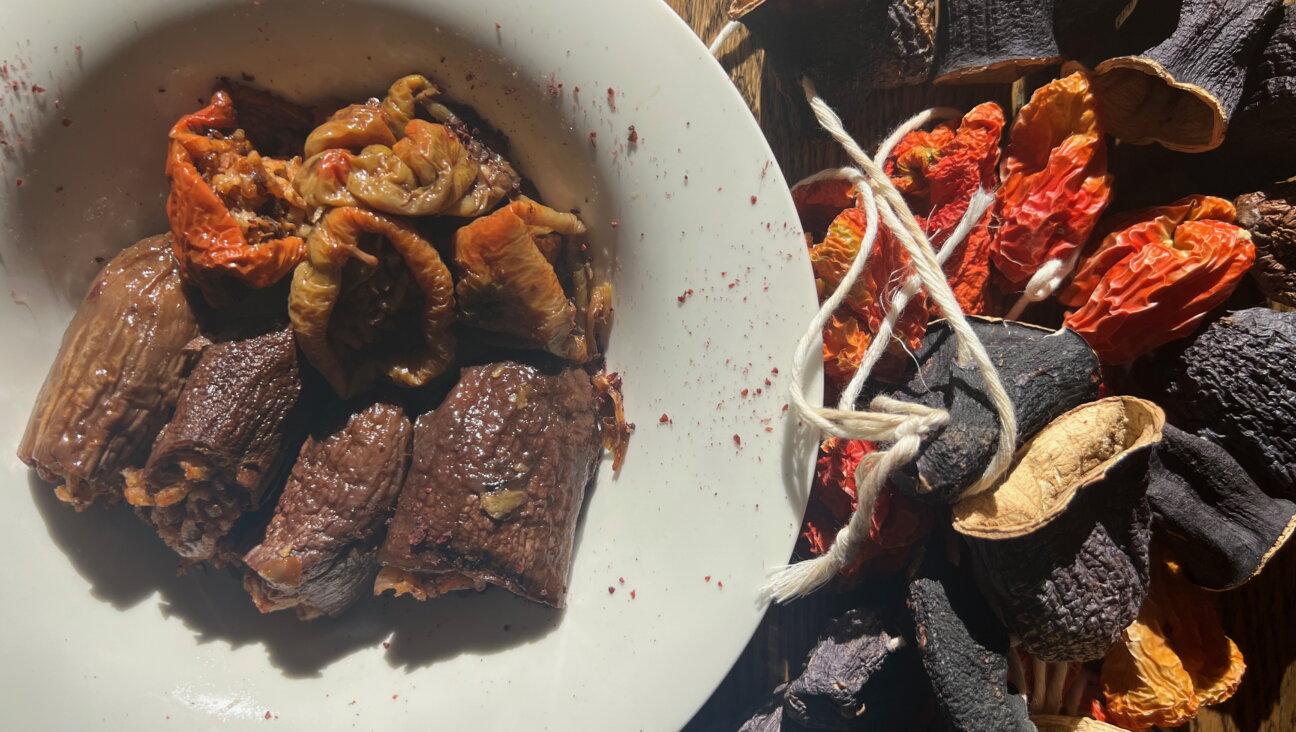In an Expansive New Cookbook, Leah Koenig Takes on the Jewish Culinary Canon

Leah Koenig’s latest cookbook Image by Leah Koenig
What is Jewish cooking?
“It depends entirely on whom you ask,” Leah Koenig answers in the introduction to her latest book, “The Jewish Cookbook,” which contains over 400 Jewish recipes from around the globe.
“Jewish communities fanned out from the Middle East to places near and far,” she writes. “These communities were bound together by a shared basic set of liturgy and laws. They were also deeply influenced by the customs, people, and ingredients found in their new homes.”
Koenig, whose previous cookbooks include “The Hadassah Everyday Cookbook” and “Modern Jewish Cooking,” points out that her new book isn’t the first to present Jewish food in a global context rather than homing in on Ashkenazi, Sephardic, or Mizrahi foodways. She cites Claudia Roden, author of “The Book of Jewish Food,” and Joan Nathan, whose many cookbooks include “King Solomon’s Table: A Culinary Exploration of Jewish Cooking From Around the World.” She’s particularly indebted to food writer and culinary historian Gil Marks — “I dedicate the book to Gil Marks,” she said, “because I stand on his shoulders for sure.”
Still, Koenig said that her new book, published by Phaidon, couldn’t have existed until now, “because Jewish food was different 20 or 30 years ago,” she said. “Jews are constantly moving, taking traditional foods and putting them in new contexts. So even if there were books doing global Jewish food, Claudia’s book didn’t have any Ethiopian recipes in it. It’s no fault of hers, but Ethiopian Jews have only recently moved to Israeli. I have recipes from the Ugandan Jewish community, which is still not a very well known Jewish community.”
Awareness of these farther-flung Jewish cuisines is growing, Koenig says, in part because social media and the Internet are bringing cultures together, and party because of chefs who are elevating Jewish cuisine and exploring new ways of interpreting it on the plate. “So you’re starting to see the evolution of Jewish cuisine happen at a faster rate,” she said. “It’s changing really quickly and my goal for this book was to capture this particular moment in time and sort of capture the beauty of the world of Jewish cuisine.”
That she does. With such an ambitious scope, the book might have felt dense, but it doesn’t: it’s easy to navigate, divided into clear categories such as Breakfast, Soups & Stews, and Dumplings, Noodles & Kugels, with enough white space around each recipe to make it easy on the eyes. Each recipe is accompanied by a few sentences about where it’s from and for what occasion it might be served. There’s a lot of information, but it’s served up in easily digestible portions.
Even for a Jewish-food authority like Koenig, creating such a comprehensive book must have been daunting. During the research process, she said, she quadrupled an already robust Jewish cookbook collection.
“I found a cookbook from the Jews of Cochin, India, and one from the Jews of Greece that was published in the 1980s,” she said. “I wasn’t looking for recipes, I was looking for dishes, to make sure I wasn’t missing anything.”
She also cooked with a lot of people, including older women from Syrian, Morocco, Greece and Turkey. “I didn’t have to travel to those places, because Jews don’t usually live in those communities anymore,” she said. “So I cooked with a lot of women and learned techniques that I didn’t know, I learned dishes I didn’t know.”
She also reached out to friends, including Persian and Ethiopian Jews. “I would email them and ask, ‘What dishes are on your family’s tables at the holidays?’” she said. “I’ve been writing about Jewish food for more than 10 years now. It’s amazing how many of them I’d never heard of. It was a gratifying research process.”
Having tested and retested over 400 recipes, did Koenig have a favorite? In fact she had two: One is called hamin macaroni — hamin being an Israeli cousin of cholent, the long-simmering Sabbath stew. This one is made with bucatini, chicken, cardamom and other spices, along with onion and eggs. “You cook it all together in a Dutch oven for a really long time,” Koenig said. “The bucatini takes on the flavor of the chicken fat. You put in a very small amount of actual liquid, so it gets a little kugel-y, not mushy — a pudding-like consistency. But the top is all crunch and it’s really good.”
The other recipe she highlighted is for kugelhopf, an Alsatian cake-bread made with yeast, that’s similar to the Italian Christmas cake panettone. “It’s a big, fluted bundt-pan cake that has almonds and dried fruit and lemon zest.” While it can be made in a regular bundt pan, Koenig encourages the reader to spring for an actual kugelhopf pan, available on Amazon for $20. “It’s this beautiful tall cake,” she said. “It’s totally worth the investment of 20 bucks because it doesn’t look the same in a bundt pan.”
Whether originally from Alsace or Israel; India or Morocco, the dishes that make up the “The Jewish Cookbook” are distinct in flavor and technique but bound together by a shared religion. That so many of them can now be found in one place makes the vast world of Jewish food feel that much smaller and more widely accessible.
“Leah shows us that Jewish food is not defined by place, but by spirit, culture, and faith in so many senses of the world,” food writer Julia Turshen writes in the book’s introduction. “Unlike just about every other cuisine in the world, Jewish food is not distinguished by geography. It is a diasporic cuisine, which means it’s also defined by resilience, adaptability and infinite adjustments, longing and remembering, and often homesickness — even if home is no longer.”
With “The Jewish Cookbook,” Leah Koenig offers a taste of home — wherever that may be.
Liza Schoenfein is senior food writer for the Forward. Follow her on Instagram @lifedeathdinner
The Forward is free to read, but it isn’t free to produce

I hope you appreciated this article. Before you go, I’d like to ask you to please support the Forward.
Now more than ever, American Jews need independent news they can trust, with reporting driven by truth, not ideology. We serve you, not any ideological agenda.
At a time when other newsrooms are closing or cutting back, the Forward has removed its paywall and invested additional resources to report on the ground from Israel and around the U.S. on the impact of the war, rising antisemitism and polarized discourse.
This is a great time to support independent Jewish journalism you rely on. Make a gift today!
— Rachel Fishman Feddersen, Publisher and CEO
Support our mission to tell the Jewish story fully and fairly.
Most Popular
- 1

Fast Forward Ye debuts ‘Heil Hitler’ music video that includes a sample of a Hitler speech
- 2

Opinion It looks like Israel totally underestimated Trump
- 3

Culture Cardinals are Catholic, not Jewish — so why do they all wear yarmulkes?
- 4

Fast Forward Student suspended for ‘F— the Jews’ video defends himself on antisemitic podcast
In Case You Missed It
-

Culture How one Jewish woman fought the Nazis — and helped found a new Italian republic
-

Opinion It looks like Israel totally underestimated Trump
-

Fast Forward Betar ‘almost exclusively triggered’ former student’s detention, judge says
-

Fast Forward ‘Honey, he’s had enough of you’: Trump’s Middle East moves increasingly appear to sideline Israel
-
Shop the Forward Store
100% of profits support our journalism
Republish This Story
Please read before republishing
We’re happy to make this story available to republish for free, unless it originated with JTA, Haaretz or another publication (as indicated on the article) and as long as you follow our guidelines.
You must comply with the following:
- Credit the Forward
- Retain our pixel
- Preserve our canonical link in Google search
- Add a noindex tag in Google search
See our full guidelines for more information, and this guide for detail about canonical URLs.
To republish, copy the HTML by clicking on the yellow button to the right; it includes our tracking pixel, all paragraph styles and hyperlinks, the author byline and credit to the Forward. It does not include images; to avoid copyright violations, you must add them manually, following our guidelines. Please email us at [email protected], subject line “republish,” with any questions or to let us know what stories you’re picking up.
















